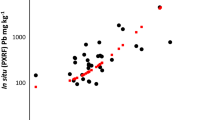Abstract
Often the amount of a substance or the activity of radionuclides in a sample is measured indirectly as the difference between signal and noise, i.e. the difference between the measured value obtained at the sample and that obtained at a sample not containing the substance or the radionuclides (blank sample). The difference can be negative, especially if the concentration or the activity is low. Since a negative measurement result for a nonnegative measurand does not make sense, measured values must be corrected to nonnegative measurement results. We deal with the situation in which it is known that the measurand is 0 with a probability \(p_0\) that is a priori known, and that the standard deviation \(\sigma\) of the measurement is known. For this case Korun, Vodenik and Zorko extend an earlier paper by Korun and Zorko and derive the mean of the posterior distribution as a Bayesian estimator of the measurand. We offer an estimator that is based on the posterior probability \(\hat{p}_0\) of the measurand being 0. If \(\hat{p}_0 > 1 - \hat{p}_0\) it is 0 and otherwise the mode of the posterior distribution. This estimate is easier to calculate and less biased than that of Korun et al.


Similar content being viewed by others
References
Cowen S, Ellison LR (2006) Reporting measurement uncertainty and coverage intervals near natural limits. Analyst 131:710–717
International Standard ISO 11843–1 (1997) Capability of detection-part 1: terms and definitions. Geneva: International Organization for Standardization
International Standard ISO 11843–2 (2000) Capability of detection-part 2: methodology in the linear calibration case. Geneva: International Organization for Standardization
Currie LA (1995) Nomenclature in evaluation of analytical methods including detection and quantification capabilities. Pure Appl Chem 67:1699–1723
Currie LA (1997) Detection: international update, and some emerging di-lemmas involving calibration, the blank, and multiple detection decisions. Chemom Intell Lab Syst 37:151–181
Weise K, Hübel K, Rose E, Schläger M, Schrammel D, Täschner M, Michel R (2006) Bayesian decision threshold, detection limit and confidence limits in ionising-radiation measurement. Radiat Prot Dosim 121:52–63
Korun M, Maver Modec P (2010) Interpretation of the measurement results near the detection limit in gamma-ray spectrometry using Bayesian statisics. Accred Qual Assur 15:515–520
Korun M, Zorko B (2013) Reporting measurement results of activities near the natural limit: note and extension of the article ”Interpretation of measurement results near the detection limit in gamma-ray spectrometry using Bayesian statistics”. Accred Qual Assur 18:175–179
Wilrich P-Th (2014) Note on the correction of negative measured values if the measurand is negative. Accred Qual Assur 19:81–85
Korun M, Vodenik B, Zorko B (2016) Calculation of the best estimates for measurements of radioactive substances when the presence of the analyte is not assured. Accred Qual Assur 21:191–195
Sadler WA, Smith MH (1986) A reliable method of estimating the variance function in immunoassay. Comput Stat Data Anal 3:227–239
Author information
Authors and Affiliations
Corresponding author
Additional information
Papers published in this section do not necessarily reflect the opinion of the Editors, the Editorial Board and the Publisher.
A critical and constructive debate in the Discussion Forum or a Letter to the Editor is strongly encouraged!
Rights and permissions
About this article
Cite this article
Wilrich, PT. Note on the correction of negative measured values if the measurand is positive or 0 with known probability. Accred Qual Assur 22, 227–232 (2017). https://doi.org/10.1007/s00769-017-1264-x
Received:
Accepted:
Published:
Issue Date:
DOI: https://doi.org/10.1007/s00769-017-1264-x




